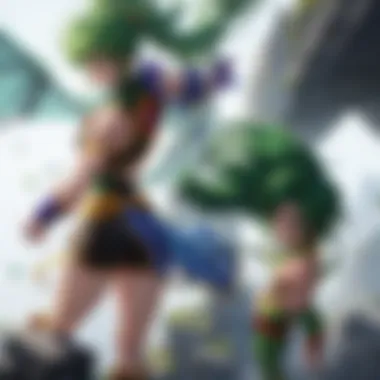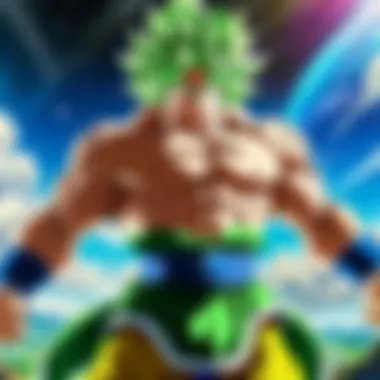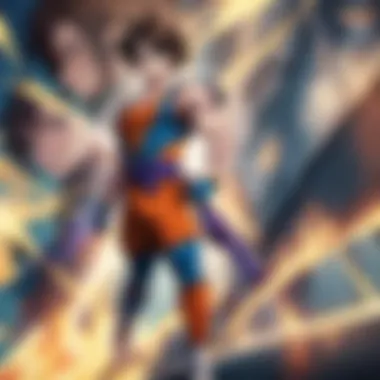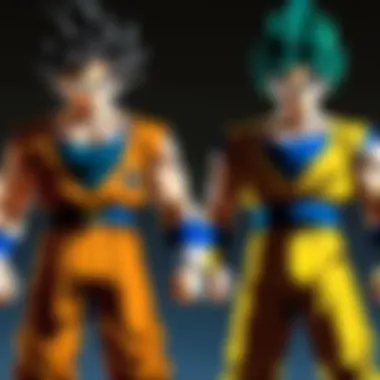In-Depth Analysis of Dragon Ball Z: Super Broly


Intro
The world of Dragon Ball is vast and richly woven with narratives that have captivated audiences for decades. In Dragon Ball Z: Super Broly, we see a revival and reimagining of one of the most iconic characters in the franchise. This film not only introduces Broly anew but also intertwines with established lore, offering fans a fresh yet familiar experience. To fully appreciate this film, it is crucial to understand the broader context of the Dragon Ball series, its characters, and the themes that resonate throughout the story.
Featured Series or Manga
Overview of the Series
The Dragon Ball series began as a manga created by Akira Toriyama, debuting in 1984. It quickly gained popularity and evolved into multiple anime adaptations, films, and spin-offs. Central to its allure is the blend of action, adventure, and humor, coupled with complex character relationships and development. The franchise has stood the test of time, maintaining relevance in contemporary anime culture and continually attracting new audiences.
Key Characters and Development
Characters are at the heart of the Dragon Ball series. From Goku's unwavering determination to Vegeta's pride, each character adds depth to the narrative. Broly, previously introduced in non-canon films, undergoes significant development in Super Broly. His character is not merely a powerful entity but is portrayed with emotional depth and backstory, allowing for greater audience connection.
Character Analysis
Major Characters
- Goku: The ever-optimistic and powerful Saiyan protagonist, who continually seeks stronger opponents.
- Vegeta: Goku’s rival, characterized by deep-seated pride and a complex path towards redemption.
- Broly: Initially depicted as a one-dimensional force of destruction, the film softens his narrative, presenting him as a tortured soul shaped by isolation and pain.
Character Arcs and Growth
Each character experiences a unique journey. Goku embodies the pursuit of strength and friendship, while Vegeta evolves from a villain to an ally. In contrast, Broly's development from villainy to a nuanced character creates a unique perspective. Understanding these arcs elevates the viewer's appreciation of their interactions and the film’s overall impact.
Thematic Exploration
Main Themes and Messages
The film explores several themes, such as the nature of family, the burdens of heritage, and the quest for identity. Broly's struggle with his past and his relationship with his father, Paragus, underpin the narrative, demonstrating how familial expectations can shape one's destiny. The intersection of strength and vulnerability resonates throughout this story, inviting viewers to reflect on their connections.
Cultural Context and Influences
Dragon Ball Z: Super Broly is influenced not only by the franchise's long-standing themes but also by contemporary cultural discussions about power and identity. The way characters navigate their relationships underscores broader societal issues, making the film relevant beyond just entertainment.
"The reinterpretation of Broly highlights the evolution of storytelling within anime, showcasing a shift towards more complex narratives that reflect real human dilemmas."
Prolusion to Dragon Ball Z: Super Broly
The introduction of Dragon Ball Z: Super Broly is essential in understanding both the film's narrative framework and its broader implications within the franchise. This section will delve into the roots and significance of Super Broly, establishing a context for its critical analysis.
Overview of the Dragon Ball Franchise
The Dragon Ball franchise is a monumental presence in anime and manga. Originating from Akira Toriyama's manga, it has evolved into a staple of pop culture worldwide. The series first debuted in 1984, enthralling audiences with its blend of action, fantasy, and character-driven storytelling. Over the decades, Dragon Ball has spawned multiple series, including Dragon Ball Z, Dragon Ball Super, and various movies, where iconic characters like Goku, Vegeta, and Piccolo navigate their universe filled with powerful foes and high-stakes battles.
The franchise’s influence is far-reaching, as it has inspired countless other works in the genre. Its focus on training, self-improvement, and intense battles resonates with a wide range of audiences. This landscape laid the groundwork for Super Broly, offering a fresh outlook on a character who has long been associated with brute strength.
Significance of the Super Broly Film
Super Broly holds a significant place in the Dragon Ball franchise for various reasons. It reintroduces Broly, a character who initially appeared in non-canonical films and was largely defined by his rage and power. This film revitalizes Broly's narrative, weaving a more profound story around his character and motivations.
The film is notable for its high-quality animation and production value, setting a new standard for anime films. It serves not just as a film for fans, but as a bridge to new audiences, showcasing the depth of the franchise's storytelling capabilities.


The resurgence of Broly's character accentuates themes of identity, acceptance, and the struggle against one’s destiny, enhancing its relevance in modern narratives.
In addition, Super Broly reflects the franchise's evolution, showcasing how it has adapted to contemporary storytelling while maintaining its roots. For fans and newcomers alike, the film represents a crucial turning point that could influence future developments in the Dragon Ball universe. This analysis will explore these elements in detail, uncovering what makes Super Broly so pivotal not just for Broly himself, but for the overarching narrative of the series.
Narrative Structure of Super Broly
The narrative structure of Dragon Ball Z: Super Broly plays a critical role in how the story is conveyed and perceived. This section will explore key elements such as plot summary, pacing, storytelling techniques, and the use of flashbacks. Understanding these components provides insight into how the film operates on a deeper narrative level, enhancing the viewer's engagement and emotional connection to the characters and story.
Plot Summary
Super Broly offers a fresh narrative that dives into the origins of its titular character. The story spans several decades, focusing primarily on Broly, the Saiyan warrior with extraordinary powers. The plot begins with the destruction of Planet Vegeta, the Saiyan homeworld, paired with the escape of Broly and his father, Paragus. The narrative unfolds as Goku and Vegeta, two iconic heroes from the franchise, encounter Broly under intense circumstances. This confrontation leads to a series of epic battles, prompting exploration of themes like rage and revenge fueled by historical animosities.
The film does not shy from illustrating Broly's tragic backstory, creating a multifaceted character. It reveals how isolation from the Saiyan race forged Broly's identity. From his childhood on a desolate planet to eventual clashes with the Z fighters, every segment strengthens the understanding of his motivations. By the film's conclusion, audiences witness Broly's transformation not only as a fighter but as a independent being seeking acceptance.
Pacing and Storytelling Techniques
Pacing in Super Broly is another significant aspect of its narrative structure. The film efficiently balances action with character development. Fast-paced sequences propel the action forward while also allowing moments for character interaction and reflection. This duality keeps viewers engaged, ensuring that action does not overshadow emotional depth.
The use of visual storytelling is prominent in this film. The creators use striking visuals and minimal dialogue to communicate complex emotions. For example, intense battle scenes are punctuated with close-ups of character expressions, conveying their struggles without excessive exposition. The amount of screen time dedicated to fight sequences and still moments is well-calibrated, promoting a seamless viewing experience.
Role of Flashbacks in the Narrative
Flashbacks play a crucial role in enriching the narrative of Super Broly. They provide context for Broly's past, detailing his early life and the events that shaped his character. These snippets serve to bridge the present action with significant moments from history, enhancing depth and viewer connection. For instance, flashbacks reveal Broly's bond with his father while also contrasting it with Goku's and Vegeta's backgrounds. This not only establishes a sense of empathy but allows for a poignant examination of different paths characters have taken.
Moreover, flashbacks inform the audience of critical lore surrounding the Saiyans. This contextual knowledge elevates key moments within the film, allowing fans to appreciate subtle references to the broader Dragon Ball universe. By intertwining past and present narrative threads, the film creates a rich tapestry of storytelling that resonates with enthusiasts familiar with the series' history.
"The narrative structure of Super Broly isn’t just about storytelling; it’s about enriching character arcs through impactful pacing and the strategic use of flashbacks."
Character Development in Super Broly
Character development is crucial for the richness of any narrative. In Dragon Ball Z: Super Broly, this aspect takes center stage, particularly through its protagonist, Broly. The character's transformation from a mere antagonist to a deeply nuanced individual serves not only to engage the audience but to explore themes of violence, acceptance, and personal identity. By investing time in Broly's backstory, the film adds layers of emotional depth that resonate with viewers. Moreover, the interplay between Broly and the supporting characters enhances the overall character arcs, making them integral to understanding Broly's place in the broader narrative.
Broly's Character Arc
Broly's character arc in Super Broly is defined by his journey from being a misunderstood warrior to a figure seeking purpose and acceptance. Initially seen as an unhinged force of destruction, the film reveals the circumstances of his upbringing. Abandoned by his father, Paragus, and subjected to isolation and cruelty, Broly’s rage is not instinctual but cultivated through trauma.
The film showcases pivotal moments that highlight his vulnerabilities. For example, his interactions with Goku and Vegeta expose a longing for companionship, contrasting sharply with his violent past. This transition from rage to understanding invites the audience to empathize with him, ultimately framing Broly not merely as a villain but as a tragic figure.
Comparing Broly's Characterization: Old vs New
In previous portrayals, Broly was often characterized as the "Legendary Super Saiyan," focusing primarily on brute strength without substantial depth. However, Super Broly offers a fresh perspective, redefining him as a more complex character. The older version emphasized physical power with minimal emotional resonance. In contrast, the new portrayal delves into the psychological scars that shape him.
This shift raises interesting questions about narrative evolution. How do characters grow in a franchise that spans decades? In Super Broly, he's not just a powerhouse; he becomes relatable, a character shaped by loss and a quest for belonging. This richer characterization aligns Broly with contemporary standards of character development in anime, allowing for a more compelling connection with the audience.
Supporting Characters and Their Roles
The supporting characters in Super Broly provide vital context and depth to the narrative. Goku and Vegeta's roles are pivotal, as they serve as mirrors and foils to Broly’s character. While Goku embodies a carefree spirit, Vegeta's stoic nature presents a contrast that forces Broly to confront his own identity.
Moreover, characters like Paragus, Broly's father, complicate the narrative. Paragus’s desire for power directly contributes to Broly’s turmoil. This dynamic showcases how relationships foster character development. The supporting cast is not merely ancillary; they shape Broly's journey through their actions and motivations, illustrating the film's emphasis on interconnectedness.
Thematic Elements in Super Broly


The thematic elements in Dragon Ball Z: Super Broly are crucial in understanding its depth and resonance within the broader context of the franchise. These themes do not just provide a backdrop for the plot; they serve as powerful enhancers that enrich character arcs and drive the narrative. Significant themes such as friendship, power, violence, identity, and acceptance unfold through the actions and decisions of the characters. They invite viewers to reflect on their own experiences and emotions, making the film relevant on multiple levels.
Themes of Friendship and Teamwork
In Super Broly, the theme of friendship manifests in various forms. The relationships among the characters illustrate how bonds can shape identities and direct actions. Goku and Vegeta's partnership, although complex, demonstrates how teamwork can overcome even the most formidable obstacles. Their struggle against Broly illustrates that working together is vital, even when facing a tragic figure shaped by time and circumstance.
"True strength lies not only in power but in the connections we forge with others."
The narrative also emphasizes how friendship can heal. Broly, who starts as a lonely and misunderstood character, discovers a sense of camaraderie through his interactions with Goku and others. This development showcases the transformative power of companionship, which remains a constant throughout the Dragon Ball series.
Exploration of Power and Violence
The theme of power in Super Broly is intricately linked with the notion of violence. The film explores how power can corrupt or uplift individuals depending on the circumstances. Broly’s immense power is both a gift and a curse, stemming from his traumatic past. His connection to violence is portrayed not just in his battle scenes but in the emotional weight of his backstory.
This exploration raises ethical questions about the use of power. Characters like Frieza demonstrate the destructive potential of power when misused. Meanwhile, the film contrasts this with Goku’s more positive approach, where power becomes a means to protect rather than dominate. Such contrasts deepen the viewer's understanding of the choices made by the characters and the consequences that ensue.
Identity and Acceptance
Identity is a central theme throughout Super Broly, particularly in how characters struggle to find themselves amid external expectations. Broly's character arc embodies this struggle. He begins as an outcast, defined solely by his power and legacy as a Saiyan warrior. Throughout the film, the journey towards self-acceptance becomes clear. His ultimate realization of who he is — beyond just a weapon of destruction — resonates deeply with audiences.
The film also highlights the importance of acceptance from others. Characters like Goku exemplify this by treating Broly not as a threat but as a fellow fighter and a potential friend. These interactions provide a narrative framework that emphasizes understanding and compassion, encouraging viewers to see past preconceived notions and recognize shared humanity.
Artistic and Technical Aspects
The artistic and technical elements of Dragon Ball Z: Super Broly are essential in understanding its overall impact. High-quality animation, an engaging soundtrack, and innovative character designs all contribute to the film's success and how it resonates with audiences. Each of these components not only enhances the viewing experience but also plays a crucial role in storytelling. Consequently, a deep dive into these aspects reveals their significance in both maintaining the franchise's legacy and appealing to contemporary viewers.
Animation Quality and Style
The animation quality in Super Broly is a standout feature. Produced by Toei Animation, the film marks a significant leap over previous entries in the franchise in terms of visual fidelity. The fluidity of the animation during fight scenes is particularly noteworthy, showcasing a level of detail that draws viewers into the action. Character movements are more natural, and the environments are richly detailed, which enhances immersion.
Using a unique art style, the film distinguishes itself from the more traditional animations of earlier Dragon Ball series. The use of vibrant colors adds emotional depth, amplifying scenes where characters experience intense feelings, such as anger or sorrow. This visual style emphasizes not just action, but the emotional stakes involved, making the anime resonate on multiple levels.
Soundtrack and Sound Design
The soundtrack of Super Broly plays a pivotal role in setting the film's tone. Composed by Norihito Sumitomo, the music blends orchestral elements with traditional anime sounds, creating a dynamic auditory experience that complements the visual themes. The score manages to heighten the drama during pivotal moments, while also providing lighter tones to balance the film's more intense scenes.
Sound design is equally important, as it enhances the overall action sequences. The sound of punches landing, energy blasts, and environmental effects immerse the audience deeper into the fictional world. Each audio element is carefully crafted to heighten the impact of the visual choreography, ensuring that viewers are fully engaged in every moment of the story.
Character Design Innovations
Character design in Super Broly introduced several notable innovations, adding depth to both main and supporting characters. The film's rendition of Broly, for instance, showcases a more nuanced visual style that captures his tragic background. His design is striking, with features that indicate both his Saiyan heritage and his struggles with identity. This attention to detail establishes a connection between the character and the audience, making his arc more impactful.
Other characters, such as Goku and Vegeta, also received subtle design updates. These revisions help portray their growth and evolution throughout the series. Significant characters like Paragus and Frieza were also redesigned to reflect their personalities more precisely.
In summary, the artistic and technical aspects of Dragon Ball Z: Super Broly are not just enhancements; they are integral components that elevate the storytelling. The animation quality, soundtrack, and character designs create a cohesive experience that engages the audience, emphasizing emotional connections and resonating themes. As such, these elements are not merely background details; they are vital to the film's success and legacy within the Dragon Ball franchise.
Broly's Impact on the Dragon Ball Franchise
The introduction of Broly in the Dragon Ball Z: Super Broly film has marked a significant turning point for the franchise. Broly resonates not just as a character but as a pivotal figure within the Dragon Ball universe. His presence challenges the existing narratives and revitalizes interest among long-time fans and newcomers alike. The exploration of Broly's impact encompasses several critical areas.
Reception Among Fans and Critics


Broly's return in Super has been met with overwhelming enthusiasm from the fanbase. Many fans appreciate the depth of character development in this iteration compared to the earlier, more one-dimensional portrayal. Critics noted that the film successfully aligned Broly's motivations with contemporary storytelling techniques. The blend of thrilling action sequences and emotional moments struck a chord with audiences.
- Positive Feedback: The visuals and action choreography, lauded for their quality, enhanced the viewing experience.
- Engagement with the Story: Fans found the story engaging, with Broly's motives closely mirrored by themes of identity and acceptance.
Summarily, the film has not only repurposed Broly's character but reinvigorated discussions about the series as a whole, establishing a more nuanced dialogue between fans and creators.
Evolution of Broly as a Character
Broly's evolution from the early Dragon Ball Z movies to this film is striking. Initially presented as a ruthless powerhouse with little background, he now stands as a complex character shaped by circumstances beyond his control. In Super Broly, his upbringing and relationship with his father, Paragus, are examined in greater detail.
- Transformation from Antagonist to Protagonist: This shift is crucial in changing perceptions about his character.
- Character Relationships: His interactions with Goku and Vegeta showcase a more vulnerable side, paving the way for potential alliances.
This evolution underscores a broader theme in Dragon Ball, illustrating growth in character development standards within anime storytelling.
Future of the Dragon Ball Series Post-Super Broly
The release of Super Broly opens numerous possibilities for the future of the Dragon Ball series. With Broly now integrated into the primary continuity, future stories may explore his character in greater depth.
- Potential Story Arcs: Fans speculate on future arcs involving Broly, including possible team-ups with main characters.
- Franchise Expansion: The positive reception of Broly may prompt the exploration of other previously neglected characters.
"Broly's journey reflects a shifting paradigm in character portrayal within the Dragon Ball franchise, merging action with deeper narrative constructs."
All these facets combined solidify Broly's integral role within the Dragon Ball legacy.
Cultural Resonance of Super Broly
The cultural resonance of Dragon Ball Z: Super Broly extends beyond its immediate entertainment value. The film not only contributes to the legacy of the Dragon Ball franchise but also reflects broader cultural themes prevalent in modern media. Its release generated significant discussions around identity, power, and transformation, paralleling broader societal issues.
Influence on Popular Culture
Since its release, Super Broly has made a notable impact on popular culture. The film rejuvenated interest in the Dragon Ball franchise, inspiring a new wave of fans, both seasoned and new. Memes, fan art, and merchandise have flooded social media platforms, allowing individuals to express their enthusiasm and connection to the film.
- Iconic Scenes: Memorable moments, such as Broly’s transformation and the intense battles, have been replicated and shared widely. The iconic fights reflect not only Dragon Ball's unique style but also its originality in the anime genre.
- Crossover Appearances: Characters from Super Broly have appeared in various games and merchandise, further solidifying the character's place in the broader cultural lexicon. This cross-pollination shows how characters can transcend their original narratives.
Merchandising and Commercial Success
The commercial success of Super Broly serves as a case study in effective marketing and fan engagement. The film achieved massive box office results, breaking previous records for anime films in many regions. The integration of merchandising has played a critical role in this success.
- Toys and Apparel: Retailers have capitalized on the film’s popularity, offering a range of products, including action figures, clothing, and collectibles that resonate with fans. Notably, the release of figurines inspired by Super Broly has attracted collectors and casual buyers alike.
- Collaborations: Collaborations with popular brands have created limited edition products that appeal to various consumer demographics, meaning that Broly's image has merged with those outside the immediate fanbase.
"The success of Super Broly not only reinforces the character's significance but also highlights the effective globalization of anime culture, marrying it with mainstream entertainment."
Epilogue
The conclusion of an article about Dragon Ball Z: Super Broly serves as a pivotal moment to synthesize insights gathered throughout the analysis. This section highlights the significance of the film within the broader context of the Dragon Ball franchise, as well as its lasting impact on both fans and the anime medium.
One critical element to consider is the exploration of character development. The film redefines Broly not just as a brute force but as a complex character with a relatable backstory. This nuanced portrayal adds depth to the typical tropes of power and violence often found in shonen anime.
Additionally, the thematic examinations discussed earlier link back to the central premise of identity and acceptance, which resonate with many viewers. It is important to firelight how these themes unfold in the narrative and how they elevate the film beyond mere entertainment.
Another vital aspect is the technical excellence demonstrated in the animation and sound design of Super Broly. These artistic features not only fan the flames of viewer engagement but also underscore the film's ambition in pushing the boundaries of what an anime film can achieve.
In summary, "Super Broly" marks a significant chapter in the Dragon Ball lineage. Its mix of powerful storytelling, emotional resonance, and visual splendor are elements that deserve recognition and understanding. By positioning Broly in a more sympathetic light and intertwining complex themes, the film invites both critical and personal interpretations.
This film is not just about battles; it's about the growth of characters and relationships, as seen through the eyes of those involved.
Overall, Dragon Ball Z: Super Broly embodies a convergence of nostalgia and innovation, enhancing its reputation while setting a new standard for future anime productions. Such reflections ensure that the film will be remembered as a cornerstone in the Dragon Ball legacy.



